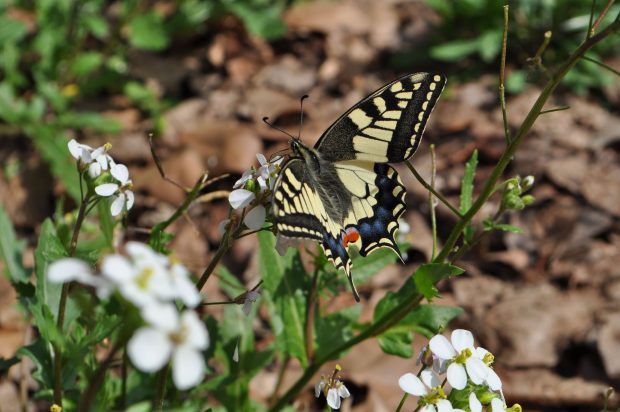The “Butterfly Gardens” project will conduct a major butterfly count in Catalonia from June 15 to 30

- The butterfly count is organized by the research group BiBio of the Granollers Natural Sciences Museum, with which the UVic – UCC BETA Technological Centre collaborates
- The initiative is inspired by the Big Butterfly Count, which started in the UK in 2010 and currently has thousands of followers
- The project promotes the creation of gardens with native plants to provide butterflies with shelter, feeding and breeding in anthropized areas (transformed by human activity)
Vic, June 4, 2025.- Over the past 30 years, the number of butterflies—pollinating and bioindicator species—has declined dramatically in Catalonia and throughout the Mediterranean region due to climate change, the disappearance of meadows, intensive agriculture, and mass urbanization. This negative trend is observed not only in the most specialist species (with a lower capacity for adaptation) but also in generalists, indicating a global loss of biodiversity. In this context, and to obtain a current snapshot of the butterfly population, a large-scale butterfly count will be carried out in Catalonia and the Balearic Islands from June 15 to 30, as part of the “Butterfly Gardens” citizen science project of the research group BiBio of the Granollers Natural Sciences Museum (MCNG), with which the BETA Technological Center of the University – Central University of Catalonia ( UVic -UCC) collaborates.
This great butterfly count will be the second to be held in 2025, after the one already organized by the group BiBio this spring. This April, 816 pollinators were recorded in 36 gardens, 505 of which were butterflies belonging to 35 different species, with the participation of 33 volunteers. The third count will take place in September. These counts, open to all, are inspired by the Big Butterfly Count, an initiative that began in the United Kingdom in 2010 and aims to involve citizens in counting butterflies and assessing the number of individuals in each region over time. Over time , the Big Butterfly Count has become the world’s largest butterfly census, with 64,000 citizen scientists participating in 2022, submitting 96,257 records of butterflies and diurnal moths from across the UK.
In Catalonia, as in the rest of Europe, these types of large-scale counts are carried out through 15-minute observations in which all the butterflies seen and their interactions with the plants are quantified. The activity is carried out in butterfly gardens, that is, in green spaces (small balconies, terraces, urban parks, private or school gardens, community gardens) in urban and peri-urban areas registered on the “Butterfly Gardens” project website.
Public involvement in this count not only benefits knowledge about these species but also helps us understand their importance to the ecosystem. These types of activities provide a true picture of the status of butterflies and allow us to observe how their abundance and richness vary over time.
A project to create favorable habitats
Butterfly Gardens project, from the group The MCNG’s BiBio program aims to reverse the decline of butterflies and other pollinators in urban and rural environments in Catalonia and the Balearic Islands by creating favorable habitats for butterflies, known as butterfly gardens. These spaces provide shelter and essential resources for these insects, such as food, breeding grounds, and suitable habitats.
To create your own butterfly garden, it’s important to keep in mind that butterflies require specific plants to complete their life cycle: adults feed on flower nectar (nectar-bearing plants), while caterpillars depend on specific food plants to grow. To encourage their presence and reproduction, a butterfly garden should include a combination of these two types of plants, preferably native varieties that bloom throughout the year. Some of the most suitable nectar-bearing plants are lavender, oregano, and mint, while the most favorable food plants for species such as the queen butterfly or the cabbage white butterfly include fennel, rue, and nasturtium.
In addition to the butterfly and pollinator monitoring program and the promotion of butterfly gardens, the project seeks to engage society in science and nature conservation by promoting practices that foster biodiversity and bringing wildlife observation into everyday life. Throughout the year, the project also offers training on how to identify different butterfly species, learn about their characteristics and interesting facts, and learn how to use a butterfly net and conduct sampling.
“The Butterfly Gardens project began just over a year ago and has been very well received, both in schools and among volunteers. Creating habitats for butterflies is easy: just rethink how we perceive the environment and the role we play in gardens. With the Great Counts, we want to reach more people and encourage them to observe these fascinant insects, says Claudia Pla-Narbona, biologist of the group BiBio and project coordinator”.
“Butterflies are bioindicators of ecosystem health because their short life cycles and high sensitivity to climate and habitat changes allow them to respond quickly. They are also easy to identify, allowing us to monitor them with volunteers and track trends.”
According to data from the Catalan Butterfly Monitoring Scheme (CBMS) , coordinated by the Granollers Natural Science Museum, 70% of butterfly species have declined in number in recent decades. Furthermore, data from the 2024 long-term butterfly monitoring project confirmed the local disappearance of 210 butterfly populations . This is due to the prolonged drought from 2021 to 2024.
